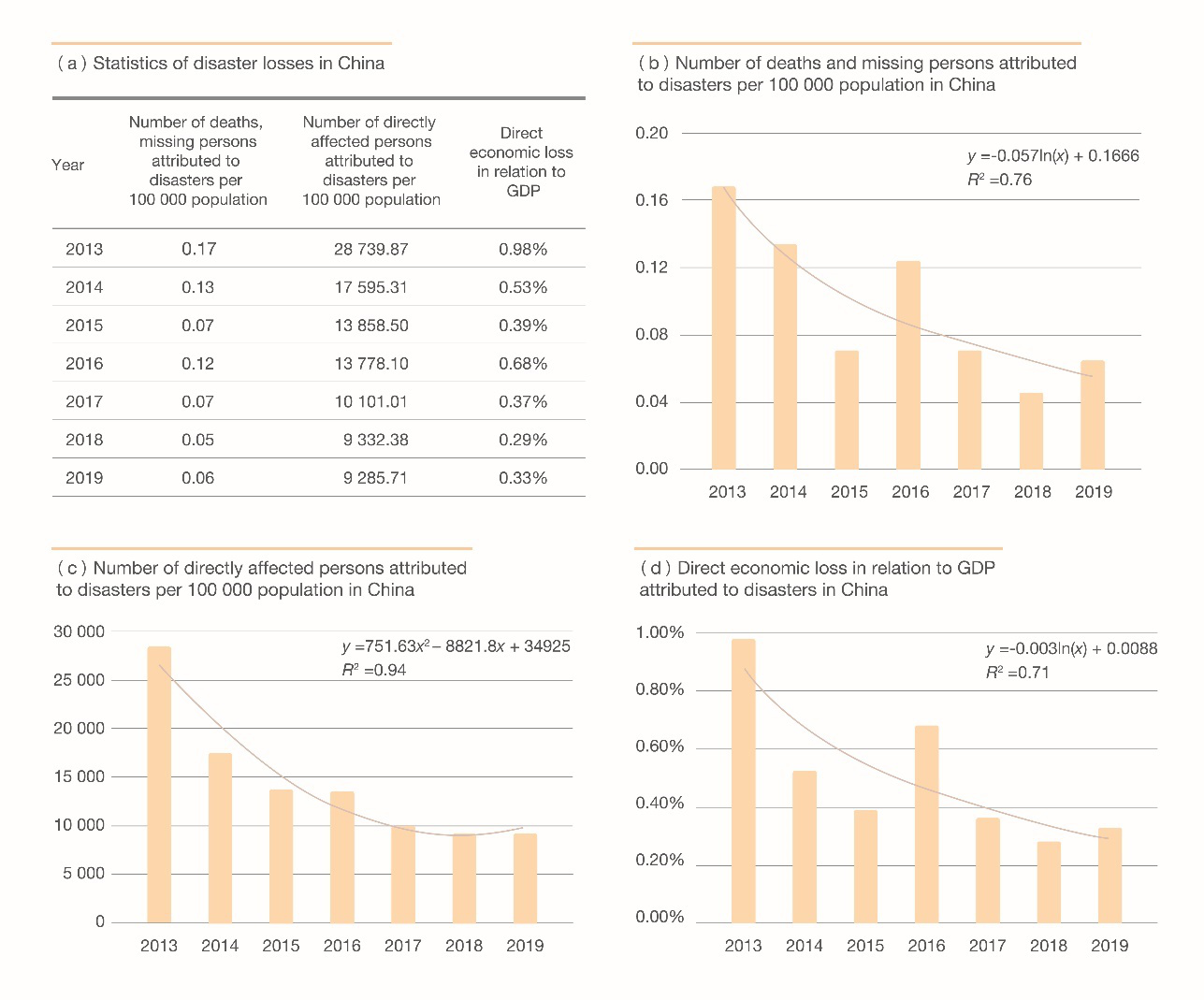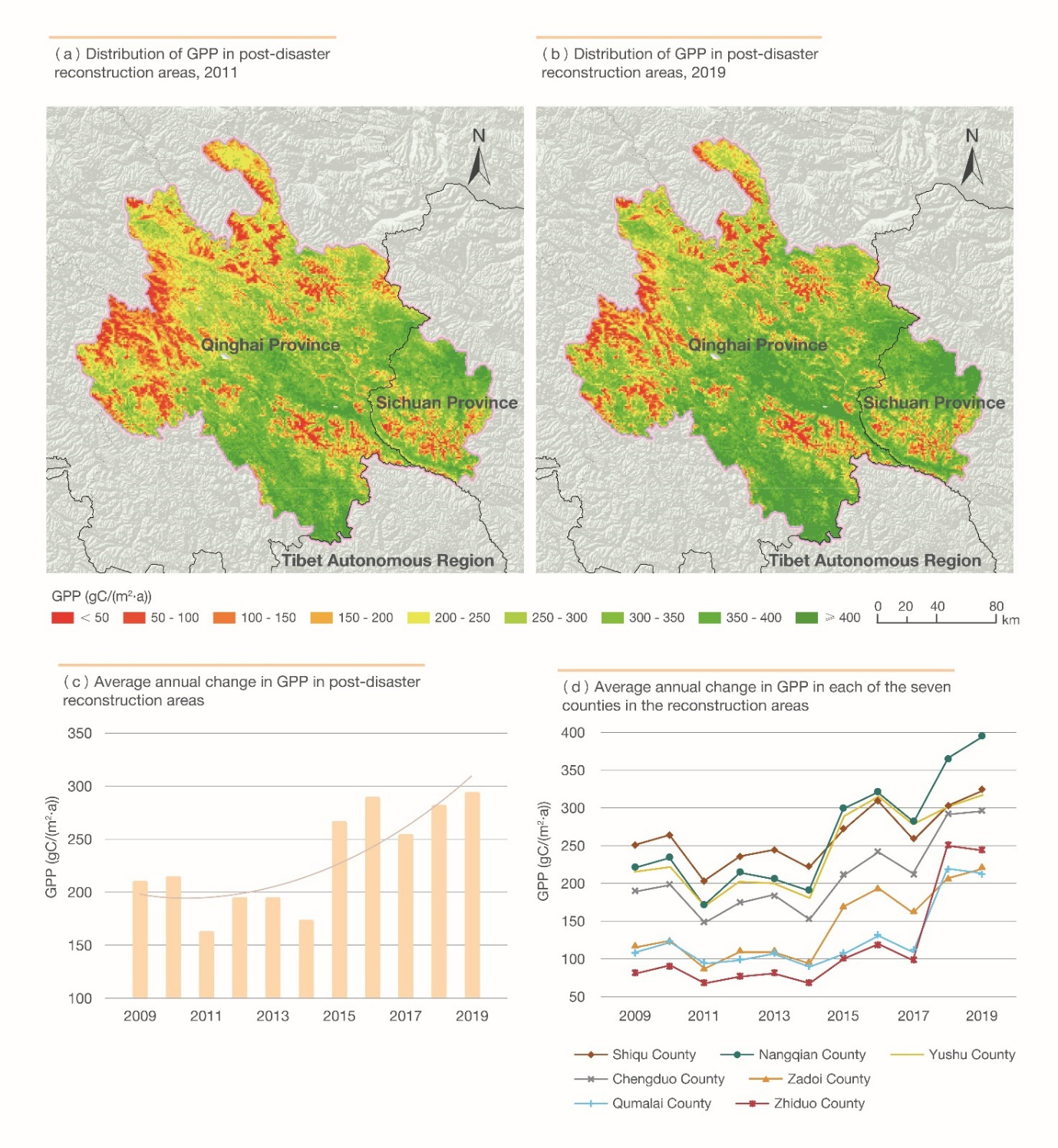SDG11: Sustainable Cities and Communities
Monitoring of disaster loss reduction and promotion of sustainable development in vulnerable areas in China(2020)
Target: 11.5 By 2030, significantly reduce the number of deaths and the number of people affected and substantially decrease the direct economic losses relative to global gross domestic product caused by disasters, including water-related disasters, with a focus on protecting the poor and people in vulnerable situations.
| Highlights |
| The losses caused by natural disasters have decreased significantly in China as a whole. Comparing 2013 and 2019, the number of deaths and missing persons per 100 000 population dropped from 0.17 to 0.06, the number of directly affected persons per 100 000 population decreased from 28 739.87 to 9 285.71, and direct economic loss in relation to GDP attributed to disasters dropped from 0.98% to 0.33%. |
Background
In this century, as urbanization and the growth of economy pick up speed, disasters have become a major constraint to sustainable development. Under the United Nations 2030 Agenda for Sustainable Development, substantially reducing losses from disasters, with a focus on protecting the poor and vulnerable groups, is an important indicator for promoting sustainable development, one that has been embraced by the Chinese government, and incorporated into its Plan of National Comprehensive Disaster Prevention and Mitigation (2016-2020). Economically backward regions in western China, especially those that had experienced major disasters, have stepped up efforts of disaster prevention and mitigation, rehabilitation and reconstruction, effectively promoting sustainable development of these disaster-prone regions.
Data used
Multi-sourced remote sensing data from 2009 to 2019: satellite remote sensing data such as Gaofen-1, Gaofen-2 and Beijing-2, as well as airborne remote sensing data.
Statistical and bulletin data from 2009 to 2019, including Chinese statistical yearbooks of regions, counties, cities, population, civil affairs; statistical yearbooks of Qinghai and Gansu; data verified by the Ministry of Emergency Management, the Ministry of Civil Affairs and the Office of the National Disaster Reduction Committee in consultation with other relevant departments on the situation of natural disasters nationwide; China's Flood and Drought Disasters Bulletin; National Geological Disasters Bulletin.
Survey data on the post-disaster reconstruction area of Yushu, 2019.
Method
Statistical and spatial data were used synergistically to finely monitor changes in disaster losses and socioeconomic development from multiple dimensions. Deep learning methods were applied to extract information from imagery on disaster-vulnerable areas, progress of rebuilding projects, distribution of buildings and construction and repair of transportation facilities. Parameter inversion of long time series of satellite remote sensing records was used to monitor in real time the state of the environment.
Results and analysis
1) Dynamic monitoring of changes in China's disaster losses
The overall monitoring of disaster losses, population and economic statistics showed that natural disaster-induced losses decreased significantly (Fig. 1). Major reductions were observed in all the indicators as of 2019, compared with those of 2013: the number of disaster-related deaths and missing persons per 100 000 decreased from 0.17 to 0.06 ; the number of directly affected persons per 100 000 population decreased from 28 739.87 to 9 285.71; direct economic loss in relation to GDP attributed to disasters decreased from 0.98% to 0.33%.

Figure 1. Changes in natural disaster losses in China (excluding Hong Kong, Macao and Taiwan province)
2) Monitoring of sustainable development in disaster-vulnerable areas of China
The vast western China, inhabited by many ethnic groups, has a high density of poor population and is prone to disasters. The Yushu earthquake and Zhouqu debris flow in 2010 and the Jiuzhaigou earthquake in 2017 had severe, negative impact on local sustainability. Big Earth Data-enabled monitoring of these disaster-vulnerable areas showed that government projects, such as disaster prevention, engineering interventions, and improving earthquake resistance of residential housing, have effectively promoted sustainable development. Table 1 and Figure 2 below show the dynamic monitoring of sustainable development in the reconstruction area of quake-hit Yushu.
Table 1 Measures to promote sustainable development in disaster-prone areas and their effects in China (using the reconstruction area in quake-hit Yushu as an example)


Figure 2. Dynamic monitoring of vegetation recovery in the Yushu post-earthquake reconstruction areas
Outlook
In recent years, China has significantly enhanced its overall capacity of disaster prevention and mitigation in cities and human settlements. Losses caused by natural disasters have dropped sharply. However, the complex disaster-prone environment, coupled with frequent extreme meteorological and hydrological conditions, poses a serious challenge to continued major reduction in disaster-induced losses and the sustainable development of vulnerable areas such as in western China. The way forward is to vigorously promote the integrated application of advanced technologies and sustainable development theories, strengthen research on the dynamics of disasters, and overcome technical bottlenecks in disaster prediction, early warning, monitoring, assessment and management.

